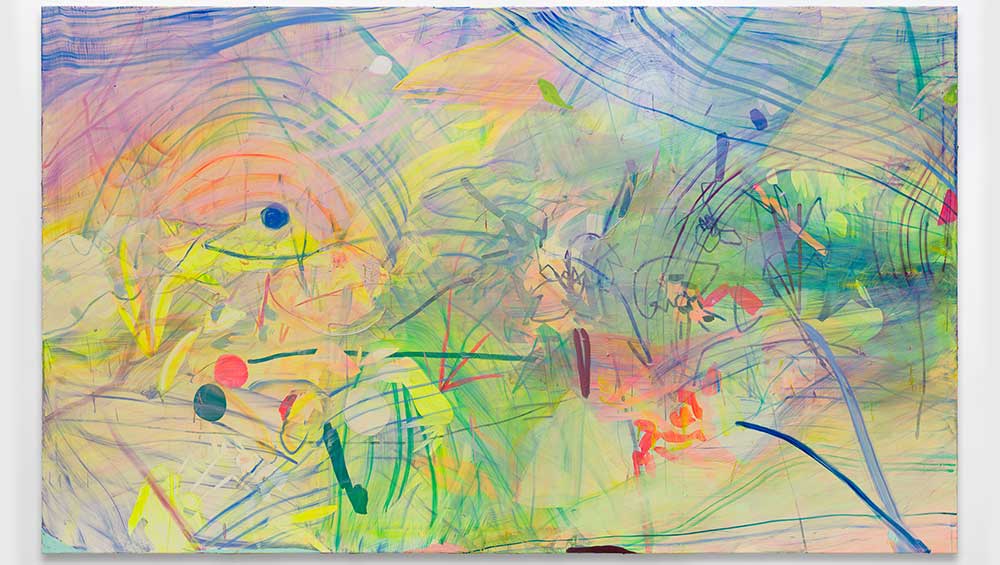
Jadé Fadojutimi. How to Protect a Smile, 2022. Acrylic, oil and oil pastels on canvas, 300 x 500 cm. Photo: Michael Brzezinski. Courtesy: Jadé Fadojutimi.
The Hepworth, Wakefield
16 September 2022 – 19 March 2023
by BETH WILLIAMSON
An exploration of colour seems to be a popular theme for exhibitions currently. To mention just two, David Batchelor’s exhibition Colour Is is at Compton Verney and Abbas Akhavan’s You Used to Call It Blue Sometimes (2022) is part of his study for a garden at Mount Stuart on the Isle of Bute. Now, Jadé Fadojutimi’s exhibition Can We See the Colour Green Because We Have a Name for It? is at the Hepworth Wakefield. Fadojutimi’s title gestures to the green and growing natural word around us and how we engage with it, but more of that later.
It is not difficult to see why Fadojutimi is attracting such attention. This prolific young painter has produced an astonishing new body of work for the Hepworth and it is the perfect venue for it. This is evident even before we enter the current exhibition. Her painting Ob-sess(h)-ion (2020), part of the Hepworth collection, is displayed with Ben Nicholson’s Delos (1954) and Barbara Hepworth’s Curved Form (Oracle) (1960). The juxtaposition of these three works, 60 years apart, is nothing short of astonishing. The modernist landscape we know from the likes of Nicholson and Hepworth is reinvigorated in the contemporary moment with Fadojutimi’s work.
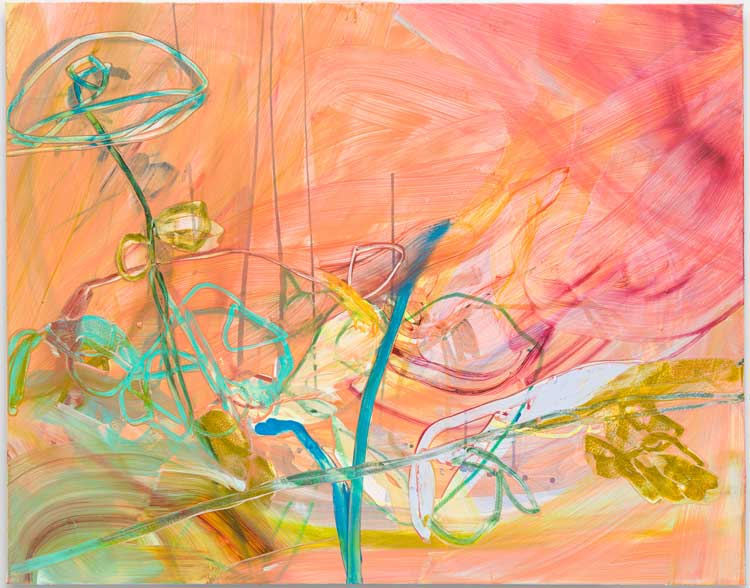
Jadé Fadojutimi. 40°C, 2022. Acrylic, oil and oil pastels on canvas, 110 x 140 cm. Photo: Michael Brzezinski. Courtesy: Jadé Fadojutimi.
In many respects, Can We See the Colour Green is a paradoxical exhibition. Gentle yet powerful, small in numbers (just eight paintings) but with individual works on a grand scale, light and dark (in tone and mood), smooth and painterly finishes in a single work, glossy and satin surfaces, and an immediacy and sense of urgency that contradicts the artist’s considered thinking on what she calls our emotional landscape. The eight paintings were selected by the artist from a larger selection she brought to Wakefield, all painted in the summer of 2022. Eleanor Clayton, senior curator, tells me that, in the end, Fadojutimi regarded the iridescent 40°C, the smallest painting on show, as the exhibition’s anchor point, and it certainly works that way as everything else seems to pivot around it.
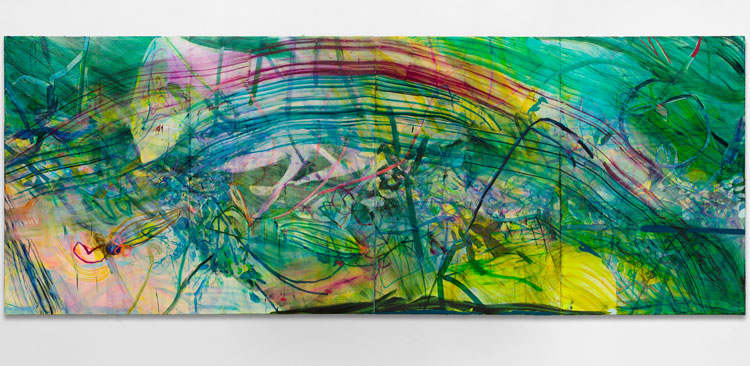
Jadé Fadojutimi. The Empress of the Plants, 2022. Acrylic, oil and oil pastels on canvas, 300 x 800 cm. Photo: Michael Brzezinski. Courtesy: Jadé Fadojutimi.
At the opposite end of the scale is the monumental work The Empress of the Plants. At eight metres long and three metres high, this is the biggest painting in the exhibition and maybe the biggest the artist has ever made, so far. It is a vibrant abstracted image, but there are hints of flowers and foliage popping out from beneath layers of paint. It is constructed from multiple painted panels, and Clayton explains how Fadojutimi moved the panels around into different configurations in the studio until she found the order she wanted. Of course, the gestural rainbow-like arc of colour that sweeps across the top of the canvas must have been added once the final configuration was settled, a finishing flourish. This painting, like all those in the exhibition, is an immersive environment for our eyes to explore. There is such depth, and a vital sense of movement within this painting, that it is easy to imagine diving in and discovering Fadojutimi’s creation with our entire being. The rhythmic qualities of line and colour evoke the movement of the artist’s body in its making and instil it with a cadence that encourages reflection in the viewer too.
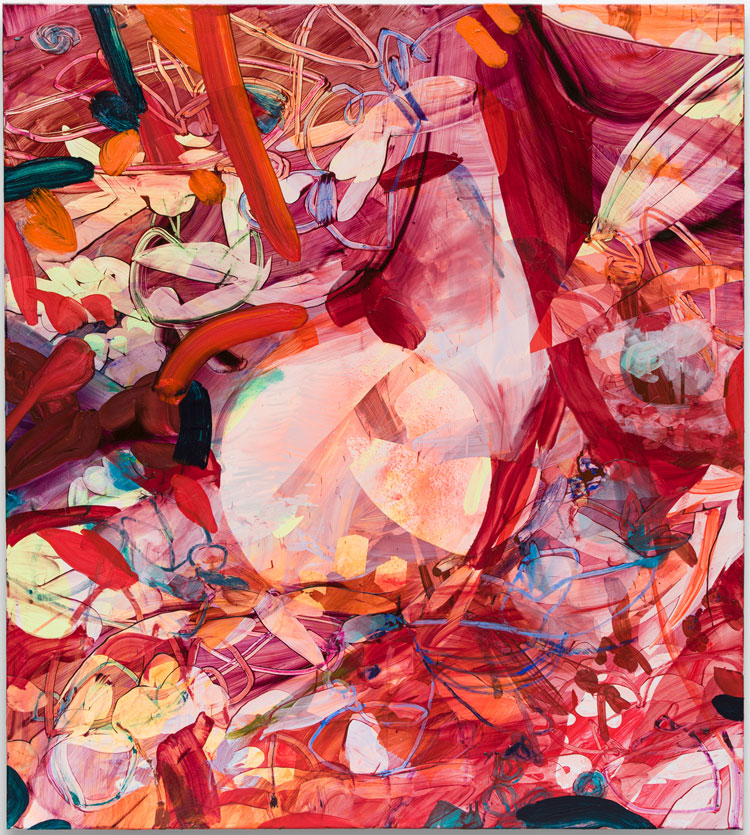
Jadé Fadojutimi. An Empathic Revolution, 2022. Acrylic, oil and oil pastels on canvas, 190 x 170 cm. Photo: Michael Brzezinski. Courtesy: Jadé Fadojutimi.
Reflecting on the recent pandemic, Fadojutimi says: “There was a moment where everyone could feel time in a way that time hadn’t been felt before. Especially when we consider an individual’s mental landscape and how it captures and creates hues of memory unique to every person.” This idea of unique memory and experience that forms an individual identity is one that the artist explores in the picture spaces she creates with layers and facets, loops, skeins and lines of colour and space. This quest for identity and the kind of raw emotion that arises from that is perhaps why the paintings are so fluid and energetic, searching for meaning in everyday experience, in nature and our connections to it.
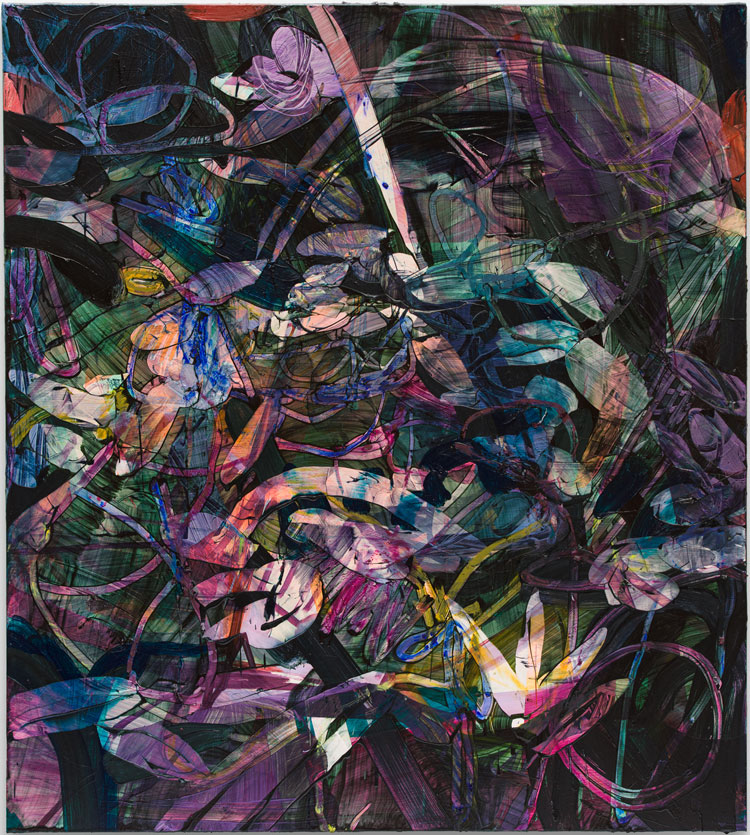
Jadé Fadojutimi. A Permeable Existence, 2022. Acrylic, oil and oil pastels on canvas, 190 x 170 cm. Photo: Michael Brzezinski. Courtesy: Jadé Fadojutimi.
Green is a healing colour for Fadojutimi and in How to Protect a Smile, painted with light-sensitive paint, she wonders: “What does the colour green mean in the dawn of global warming in relationship to every colour we hope to see and treasure in the world? As the seasons change, they remind us that change is here. So how do you protect your smile as green turns to orange and orange turns to brown?” This reference to global warming and change is a reminder that Fadojutimi’s exploration and expression of identity in her painting is not self-contained but infinitely connected through relationships to people, places, histories and geographies. This is a permeable existence. In the painting of that name, A Permeable Existence, there is darkness, an underworld or undergrowth. Small areas of impasto paint spill raggedly over the top and bottom edges of this painting, perhaps drawing attention to the undergrowth of our own lives. Yet I feel Fadojutimi’s work is more hopeful than this.
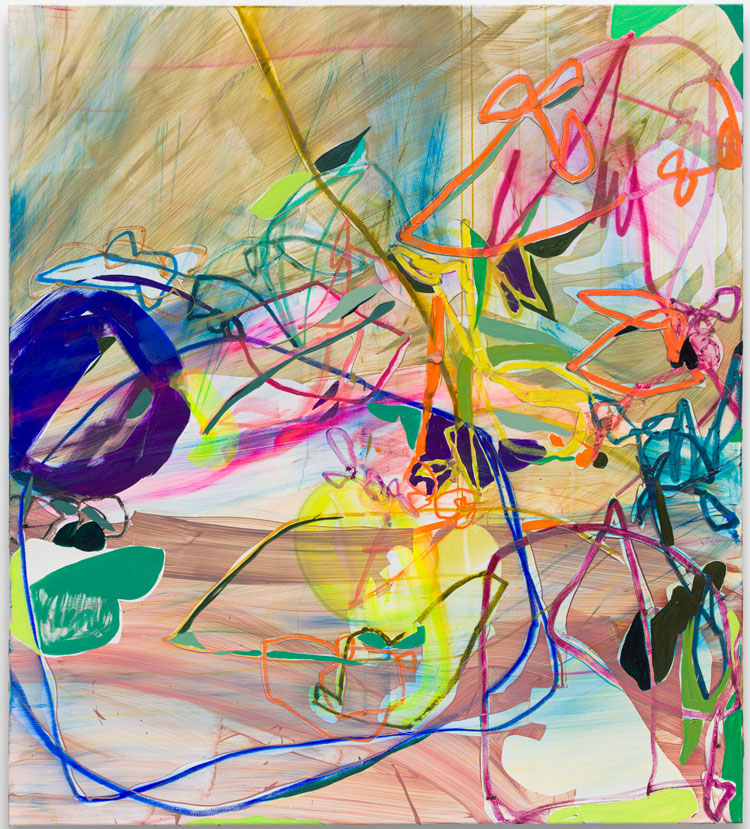
Jadé Fadojutimi. Autumn, summer, spring and winter... don’t forget to colour in between the lines darling, 2022. Acrylic, oil and oil pastels on canvas, 190 x 170 cm. Photo: Michael Brzezinski. Courtesy: Jadé Fadojutimi.
These vital paintings let in the light and the artist was so keen on getting more light into the gallery that she had a wall removed to expose a window behind it. Beyond the window, Wakefield’s Chantry Chapel of St Mary the Virgin, built in the 14th century, stands as a reminder of longevity, the staying power and continued relevance of art and architecture. David Chipperfield’s building for the Hepworth Wakefield opened in 2011, and Fadojutimi’s work in the collection was acquired in 2020. Two years on, this exhibition begins to outline her position more clearly. In years to come, Fadojutimi will surely have a well-earned place alongside Hepworth, Nicholson and others in the history of British landscape painting and in the Hepworth Wakefield collection.